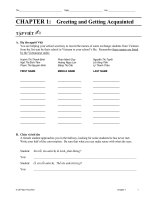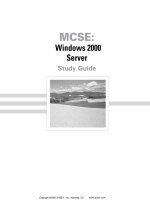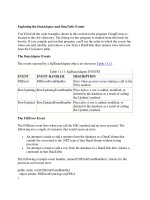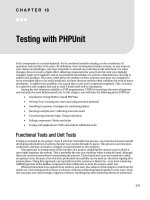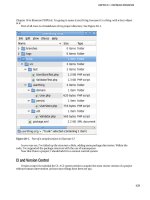Tài liệu Fieldbus Wiring Design and Installation Guide docx
Bạn đang xem bản rút gọn của tài liệu. Xem và tải ngay bản đầy đủ của tài liệu tại đây (492.39 KB, 41 trang )
Wiring Design
and Installation
Guide
Fieldbus
8493 fieldbus coverf pdf 10/15/98 1:00 PM Page 1
Fieldbus
Wiring Design and Installation Guide
1
Fieldbus Wiring Design &
Installation Guide
. . . . . . . . . . . . . . . . . . . . . . . . . . . . . . . . . . . . . . .
2
Wiring
. . . . . . . . . . . . . . . . . . . . . . . . . . . . . . . . . . . . . . . . . . . . . . . . . . . . . .
4
Signal Termination
. . . . . . . . . . . . . . . . . . . . . . . . . . . . . . . . . . . . . . . .
4
Power Conditioning
. . . . . . . . . . . . . . . . . . . . . . . . . . . . . . . . . . . . . . .
5
Signals
. . . . . . . . . . . . . . . . . . . . . . . . . . . . . . . . . . . . . . . . . . . . . . . . . . . . .
5
Wiring Limitations
. . . . . . . . . . . . . . . . . . . . . . . . . . . . . . . . . . . . . . . . .
8
Preparing the Wiring System
. . . . . . . . . . . . . . . . . . . . . . . . . . . .
19
Wiring Practices
. . . . . . . . . . . . . . . . . . . . . . . . . . . . . . . . . . . . . . . . . . .
19
Testing the Operating Network
. . . . . . . . . . . . . . . . . . . . . . . . . .
20
Fieldbus Wiring Products
. . . . . . . . . . . . . . . . . . . . . . . . . . . . . . . .
21
Fieldbus Cable
. . . . . . . . . . . . . . . . . . . . . . . . . . . . . . . . . . . . . . . . . . . .
21
Relcom Fieldbus Connection System
. . . . . . . . . . . . . . . . . . .
23
Glossary
. . . . . . . . . . . . . . . . . . . . . . . . . . . . . . . . . . . . . . . . . . . . . . . . . . .
40
RELCOM Inc.
2221 Yew Street
Forest Grove, OR 97116 USA
Tel: 503-357-5607
800-382-3765
Fax: 503-357-0491
www.relcominc.com
Fieldbus Wiring Design
and Installation Guide
The purpose of this guide is to provide information about the Fieldbus* network so that its wiring
system can be designed and installed for cost-effective and reliable operation. There are many
uses for Fieldbus and many ways it can be configured. It is not possible to give simple rules for
wiring a Fieldbus that a robot could follow and get optimum results. For this reason, this guide will
first explain how the Fieldbus works so that the wiring system can be designed intelligently to
achieve the best performance and the most reliable operation with the lowest cost.
Fieldbus is a process control network used for interconnecting sensors, actuators and control
devices to one another. A common type of Fieldbus configuration is shown below:
A twisted pair cable, called the home run connects the control room equipment with a number of
devices in the field, sensors such as pressure transducers and actuators such as valves. The field
devices can be connected to a common terminal block called the chickenfoot, or crowsfoot at a
field junction box. A terminator (T) is needed at each end of the Fieldbus cable to allow the
twisted pair to carry digital signals. The Fieldbus cable provides power to the attached devices.
A power conditioner (C) is needed to separate a conventional power supply from the Fieldbus
wiring. The devices use the shared wiring system to get their power and to send signals to one
another.
*Fieldbus is defined in ISA standard 50.02, Section 24. There are several types of Fieldbusses described in
that standard. The subject of this guide is referred to as H1 low power signaling and is commonly known as
Foundation Fieldbus.
Home Run
Chickenfoot
Power
Supply
C
T
TControl
2
FIELDBUS GUIDE RELCOM, INC.
Devices can also be connected along the home run cable with spurs (S). This is sometimes called
daisy-chain wiring.
For control systems that are limited in size, all the wiring components, power conditioner and
terminators, can be in a single wiring block to form a star configuration.
The diagrams above show only three of the many possible Fieldbus configurations. The power
supply and conditioner could be in the field or in a marshaling panel. The control device could be
in the field and only a display terminal could be in the control room. All these configurations are
possible so long as the basic signal transmission capabilities are provided – a twisted pair cable,
two terminators and a conditioned power supply.
While many devices can be on a Fieldbus, not all devices in a plant need to be on a single network.
Usually, a control device has connections to several Fieldbus networks called segments. If the
distance to a field device is longer than can be spanned by a single segment, a repeater is used to
boost the signals to and from the further segment.
Segment 1
Segment 2a Segment 2b
Segment 3
Control Repeater
Power
Supply
Control C+2T
Home Run
Spur
Power
Supply
C
T
T
Control
S S
RELCOM, INC. FIELDBUS GUIDE
3
Wiring
Fieldbus uses twisted pair wires. A twisted pair is used, rather than a pair of parallel wires, to
reduce external noise from getting onto the wires. A shield over the twisted pairs reduces the
noise further. The twisted pair and the shield combination plus any covering is called a cable.
Fieldbus cable is similar to the type used for existing 4-20 mA device wiring and, in most cases,
existing cable can be used for Fieldbus. For new installations or to get maximum performance
from Fieldbus, twisted-pair cable designed especially for Fieldbus should be used. The important
twisted-pair cable characteristics are:
Another item to check is the colors of the twisted pair wires. If possible, to avoid confusion, the
wire colors should match the color convention of existing wiring in the plant. If installing new
cable, the suggested convention is to use blue for the (–) wire and orange for the (+).
Signal Termination
When a signal travels on a cable and encounters a discontinuity, such as a wire short or open, it
produces a reflection. This portion of the signal that echoes from the discontinuity travels in the
opposite direction. The reflection is a form of noise that distorts the signal. A terminator* is used
to prevent a reflection at the ends of a Fieldbus cable. In most networks, the terminator is simply a
resistor whose value is the same as the characteristic impedance of the wire. Since the Fieldbus
cable also carries power, a simple resistor cannot be used because it would use up the power
intended for the devices. A Fieldbus terminator has a capacitor in series with the resistor to block
the DC voltage but lets the signal through to the resistor.
*A terminator used to prevent reflections is different than a wire screw terminal block that is used to
connect wires to each other.
1
uF
100
Ω
Fieldbus
Terminator
4
FIELDBUS GUIDE RELCOM, INC.
Wire Size 18 AWG (0.8 mm)
Shield 90% coverage
Attenuation 3 dB/km at 39 kHz
Characteristic Impedance 100 Ohms +/–20% at 31.25 kHz
Power Conditioning
If an ordinary power supply were to be used to power the Fieldbus, the power supply would
absorb signals on the cable because it would try to maintain a constant voltage level. For this
reason, an ordinary power supply has to be conditioned for Fieldbus. This is done by putting an
inductor between the power supply and the Fieldbus wiring. The inductor lets the DC power onto
the wiring but prevents signals from going into the power supply.
The inductor together with the capacitors in the terminators forms a circuit that can “ring” and
disrupt the signals. A resistor is placed in series with the inductor to stop this ringing. This
combination of components is a power conditioner.
In practice, a real inductor is not used but an electronic equivalent. The electronic inductor circuit
has the added advantage of limiting the current provided to the network segment if the cable is
shorted.
The voltage supplied to the Fieldbus cable can be as high as 32 V. The voltage at any device can
be as low as 9 V for the device to operate correctly. A typical Fieldbus device takes about 20 mA of
current from the cable. The Fieldbus is configured so that one of the wires has a (+) voltage, the
other wire has a (–) voltage and the shield is grounded.
A cable with the orange wire as plus and the blue wire as minus is shown above. This type
of cable is available from Fieldbus cable manufacturers. Other cables or existing plant wiring
conventions may be different. Regardless of the color convention, keep the sense of Fieldbus
polarity consistent throughout the plant.
Signals
The twisted pair cables, the terminators and the power conditioner work together as a wiring
system to carry signals between Fieldbus devices. Now let’s look at how the signals are
transmitted.
There are two ways for a device to transmit signals onto the cable, the bipolar method and the low
power, unipolar method. Both types of signals can be received by all devices so there are no
GROUND
+
ORANGE
–
BLUE
Power
Supply
Fieldbus
50 Ω 5 mH
RELCOM, INC. FIELDBUS GUIDE
5
compatibility issues. At this writing (1998), the bipolar signaling appears to be universally used.
It works like this:
A bipolar signaling device draws power from the cable for its internal operation and it also draws
an additional 10 milli-amps that it "wastes". When this device transmits a high signal, it turns off
this 10 mA. This results in the signal on the wires going high. When the device transmits a low
signal, it draws 20 mA from the wires. The resulting signal waveform is shown below. Note that
the signal is above and below the non-transmitting voltage level.
A unipolar signaling device does not draw any more power from the cable than is necessary for its
internal operation. When this device transmits a low signal, it draws 20 mA from the wires. When
the device transmits a high signal, it draws no power from the wires. The resulting signal
waveform is shown below. Note that the signal is below the non-transmitting voltage level of the
cable.
The peak-to-peak signal voltage is the same as for bipolar signaling. The advantage of the
unipolar signaling is that it takes 10 mA less current from the cable.The disadvantage of the
unipolar signaling is that it may cause a cable system that is not properly terminated to ring.
6
FIELDBUS GUIDE RELCOM, INC.
Signal Voltage
Peak-to-Peak
Power Voltage
Signal Voltage
Peak-to-Peak
Power Voltage
Digital data is sent on the Fieldbus at a rate of 31.25 kbits/second. Thus, each bit cell is 32
microseconds long. The digital data, ones and zeros, is represented as a Manchester signal. A
zero is a positive signal transition in the middle of a bit cell; a one is a negative transition in the
middle of a bit cell. A sequence of Manchester encoded ones and zeros would look like this:
When a device begins transmitting, it puts out a preamble, a sequence of 8 bits with alternating
ones and zeros.
This pattern is used by the receiving devices to get synchronized to bit cell boundaries.
There are also two non-data symbols. These are N+ that is a high level during the whole bit cell
and N- that is a low during the whole bit cell. These symbols are used to make an 8-bit start
delimiter that shows where real data starts and an 8-bit end delimiter that shows where data
transmission stops.
Combining the different parts, a single transmission from a device, a frame, looks like this:
The Data portion of the frame contains information such as the address of the device for which the
Preamble Start Delimiter End DelimiterData
1 N
+
N
–
1 0 N
–
N
+
0
Start Delimiter
1 N
+
N
–
N
+
N
–
1 0 1
End Delimiter
1 0 1 0 1 0 1 0
Preamble
32 µs
0 0 1 1 0
RELCOM, INC. FIELDBUS GUIDE
7
frame is intended, identification of the type of frame, measurement values, etc. The Data portion
of a frame can be up to 266 bytes long.
The delimiters are very different from any signal pattern that might be in the Data portion of the
frame. This allows the Data portion of the frame to be unambiguously identified and allows Data
corrupted by noise to be detected. This feature makes Fieldbus much more robust than other
control networks.
Because all devices share the cable, a way must be established for only one device to transmit at
a time. Otherwise, there would be chaos on the cable with all the transmitted signals interfering
with one another. Selecting which device can transmit is performed by a special device called the
Link Active Scheduler, LAS. The LAS sends out a special frame to each device in turn to allow it to
transmit. If an oscilloscope were used to observe the signals on the Fieldbus, the display would
show frames with gaps of silence between them. A frame might be one from the LAS asking a
device to transmit data, a device broadcasting its data to other devices, a device reporting an error
condition, etc.
The discussion about how Fieldbus is used for conveying specific types of information is beyond
the scope of this Wiring Design and Installation Guide.
Now that the basic characteristics of Fieldbus wiring are known, let’s look at what happens to
power and signals on the cables.
Wiring Limitations
The size of a Fieldbus wiring system and the number of devices on a network segment are limited
by power distribution, attenuation and signal distortion:
Power
The number of devices on a Fieldbus segment is limited depending on the voltage of the power
supply, the resistance of the cable and the amount of current drawn by each device. Consider this
example:
$ The power supply and power conditioner output is 20 volts.
$ The cable used is 18 GA and has a resistance of 22 Ohms/km for each conductor. The home run
is 1 km long. Therefore, the combined resistance of both wires is 44 Ohms.
$ Each device at the chickenfoot draws 20 mA.
8
FIELDBUS GUIDE RELCOM, INC.
Since the minimum voltage needed by a device is 9 Volts, there are 20 - 9 = 11 Volts that can be
used up by the cable. The total current that can be supplied at the chickenfoot is
Voltage
= Current
Resistance
11 Volts
= 250 mA
44 Ohms
Since each device draws 20 mA, the maximum number of devices at the chickenfoot of this
example is:
250
= 12 devices
20
The Fieldbus cable can be tested for power carrying capability by simply shorting out the wires at
one end of the cable and measuring the resistance of both wires with an ohmmeter at the other
end.
The power used by Fieldbus devices varies by device type and manufacturer. Check the device
specifications to determine the device power requirements. One of the gray areas of the power
specifications is the initial inrush current and the lift-off voltage. Some devices may use a great
deal more current when they are first turned on and may require more than the 9V minimum
voltage to “lift off” and begin operating. The network power distribution calculation should be
based on the worst-case inrush current and liftoff voltage numbers. Otherwise the network may
not start up when power is first turned on.
Normally Fieldbus is powered by 24 volt supplies. The maximum voltage that can be on the
Fieldbus is 32 Volts. Devices can withstand up to +/- 35 Volts without damage. To keep the
maximum voltage on the wiring below this limit, some Fieldbus wiring blocks have built-in voltage
limiters.
When a number of devices are on the cable at different places, the power distribution calculation
becomes more involved. Following is an example:
4
A B
C
a
b
c
d
e
f
g
3
2
1
Power Supply
&
Conditioner
RELCOM, INC. FIELDBUS GUIDE
9
A network is shown with four devices designated 1 through 4. The network wiring has segments a
through g. The junctions of the segments are at A, B and C. Here are the facts about the network:
From this, the amount of current in each segment can be calculated. Starting at the devices
furthest from the power source:
Because voltage equals resistance times current, the voltage drop in each segment can be
calculated.
Segment Resistance, Ω Current in Segment, mA Voltage Drop in Segment, V
a 5 20 (due to device 1) 0.1
b 10 25 (due to device 2) 0.25
c 7 45 (due to devices 1+2) 0.315
d 9 30 (due to device 3) 0.27
e 6 75 (due to devices 1+2+3) 0.45
f 11 15 (due to device 4) 0.165
g 20 90 (due to devices 1+2+3+4) 1.8
Segment Resistance, Ω Current in Segment, mA
a 5 20 (due to device 1)
b 10 25 (due to device 2)
c 7 45 (due to devices 1+2)
d 9 30 (due to device 3)
e 6 75 (due to devices 1+2+3)
f 11 15 (due to device 4)
g 20 90 (due to devices 1+2+3+4)
Segment Resistance, Ω
a 5
b 10
c 7
d 9
e 6
f 11
g 20
Device Current Required, mA
1 20
2 25
3 30
4 15
10
FIELDBUS GUIDE RELCOM, INC.
From this, the voltage drop at each node can be calculated:
As the table above indicates, the largest voltage drop is 2.815 volts at device 2. The current
flowing in segment g is 90 mA. Therefore, the power supply and conditioner must be able to
deliver at least 90 mA. The lowest voltage that can be at the power supply/conditioner is the
9 volt minimum requires by the devices plus the 2.815 volt drop of the cable segments plus the
1 volt needed for signaling plus a safety margin of, say, 1 volt for a total of about 14 volts.
Intrinsic safety barriers can be considered segments in the network with a resistance specified by
their manufacturer. This will be covered in more detail later.
Signal Degradation Limitations
The length of a Fieldbus network is limited by what happens to the signals as they travel on the
cable.
Attenuation
As signals travel on a cable, they become attenuated, that is, get smaller. Attenuation is measured
in units called dB or deci-Bell. This is calculated:
dB = 20 log
transmitted signal amplitude
received signal amplitude
Cables have attenuation ratings for a given frequency. The frequency of interest for Fieldbus is
39 kHz. Standard Fieldbus cable has an attenuation of 3 dB/km at 39 kHz or about 70% of the
original signal after 1 Km. If a shorter cable is used, the attenuation is less. For example, a 500
meter standard Fieldbus cable would have an attenuation of 1.5 dB.
A Fieldbus transmitter can have a signal as low as 0.75 volts peak-to-peak. A receiver must be able
to detect a signal as little as 0.15 volts peak-to-peak. This means that the cable can attenuate the
signal by
20 log
0.75
=14 dB.
0.15
Since the standard Fieldbus cable has an attenuation of 3 dB/km, this indicates that the Fieldbus
can be as long as
14 dB
= 4.6 km
3 dB/km
Node Voltage Drop, V
A 1.8 (due to segment g)
Device 4 1.965 (due to segments g + f)
B 2.25 (due to segments g + e)
Device 3 2.52 (due to segments g + e + d)
C 2.565 (due to segments g + e + c)
Device 2 2.815 (due to segments g + e + c + b)
Device 1 2.665 (due to segments g + e + c + a)
RELCOM, INC. FIELDBUS GUIDE
11
This distance may be theoretically possible, but there are other factors that have to be considered.
Signals also become distorted as they travel on the cable.
Distortion Effects on Network Size
Shown below are a transmitted signal and a received signal at the end of a long cable.
The top signal is ideal in that the signal fits within the exact bit boundaries, the rise and fall
time of the signal is within the Fieldbus specification and the signal tops are nearly flat. At the
other end of a cable, the signal is distorted. Besides being attenuated, the signal does not
fit nicely within the bit boundaries, the rise and fall times are longer and the signal top is not flat.
This signal distortion is caused by varying characteristic impedance, spur connection reflections,
etc. For this reason, Fieldbus cable cannot be as long as theoretically possible if only attenuation
is a consideration.
12
FIELDBUS GUIDE RELCOM, INC.
Transmitted
Received
RELCOM, INC. FIELDBUS GUIDE
13
There are many causes for signal distortion. Spurs on the cable are one source. Although it is not
possible to provide a definitive analysis of the effects of spurs, here are some guidelines that will
help estimate if a particular network will work or is close to having problems. Consider the
network below where the lengths of the cable segments are shown in meters.
It is not clear in this network which is the home run cable and which are the spurs. In such a
network, place the terminators as far away from one another as possible. In this example, they
are shown as "T". Consider the cable between the terminators to be the home run cable.
Consider all other cables segments as spurs.
Testing of various cable configurations for signal distortion has shown that spurs up to 300 meters
in length do not present a problem. The issue is to determine the allowable number of spurs. A
way to estimate this is as follows:
The effect of a spur on the signal is very similar to that of a capacitor (providing the spur is less
than 300 meters long). As an estimate, the capacitance of Fieldbus cable is about 0.15 nF/meter.
In this example, the network can be modeled as the home-run cable with attached capacitors.
In this model, the home run cable length is 1035 meters. The capacitance is calculated from the
total cable length of each spur.
3nF
4nF
3nF
17nF
14nF
14nF
T
T
25
600 40010
20
20
20
20
20
20
30
15
15
15
15
10
10
25
25
25
25
25
600 400
40
T
T
From the measurements of actual cable, it has been determined that the worst case signal
distortion occurs if all the capacitors are on one end of the home run cable. In this example this
would be modeled as
Again, from cable measurements it was determined that signal attenuation due to capacitance is
0.035 dB/nF. In this example, attenuation can be calculated as that caused by the cable plus that
caused by the capacitance:
1035 meters x 3 dB/meter + 55 nF x 0.035 dB/nF = 5 dB
This is well within the 14 dB allowed between the lowest level transmitter and the least sensitive
receiver. There are other signal distortions caused by spurs, but these are insignificant.
Please note that the results of measurements of signals on long cables and the analysis of spurs
in the above discussion are different from the recommended network size and spur lengths in the
Fieldbus standard. The standard's recommendations are much more restrictive and are
summarized below. In case there is a question about signal levels or fidelity, use a Fieldbus Tester
to examine the signals before the network begins operation or during operation.
The fieldbus standard contains estimates of how long a Fieldbus cable can be and still get
adequate signal quality. For the standard Fieldbus cable, and some types of existing cables used
for control applications, the limits are:
Cable Distance, Characteristic Resistance, Atten,
Type meters (feet) Impedance Ohms/km dB/km Description
Type A 1900 (6270) 100 22 3 Each twisted
(Standard pair has a shield
Fieldbus)
Type B 1200 (3960) 100 56 5 Multiple twisted
pairs with
overall shield
Type C 400 (1320) Unknown 132 8 Multiple twisted
pairs, no shield
Type D 200 (660) Unknown 20 8 Multiple
conductor cable,
no pairing of wires
1035m
55nf
14
FIELDBUS GUIDE RELCOM, INC.
There are also estimates in the standard for the length of spurs and how many devices can be on
various lengths of cable.
These are only estimates. The quality of existing cable may vary a great deal. Some existing cable
may be very good while other cable of the same type may be waterlogged, have deteriorated
insulation or be mechanically damaged. The only real way to determine if existing cable is suitable
for Fieldbus or if new cable has been installed correctly is to use a Fieldbus Tester.
Number of Devices Maximum Total Spur Length
1 - 12 120 m
13 - 14 90 m
15 - 18 60 m
19 - 24 30 m
25 -32 no spurs allowed; devices must be attached
directly to homerun cable.
RELCOM, INC. FIELDBUS GUIDE
15

